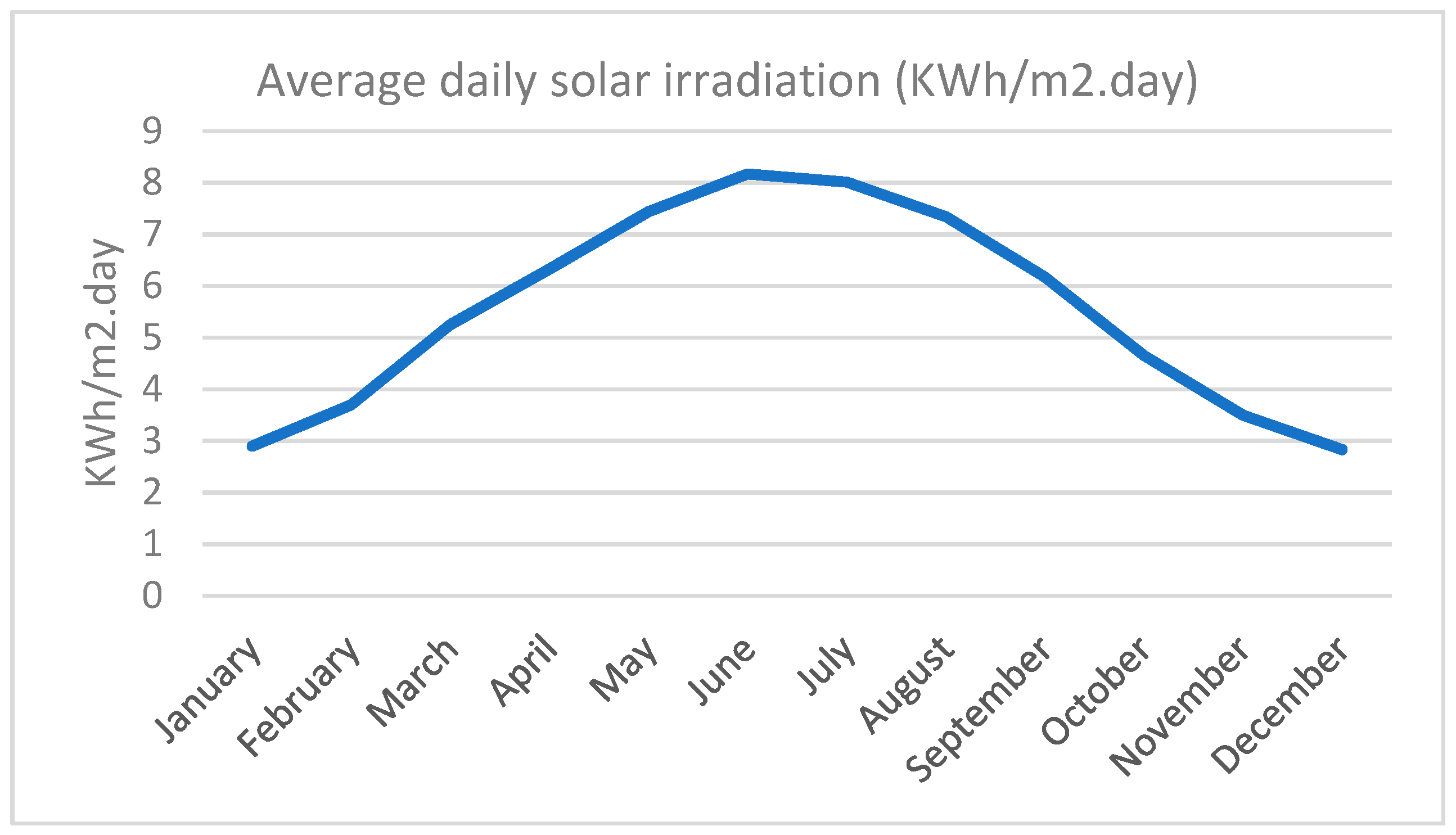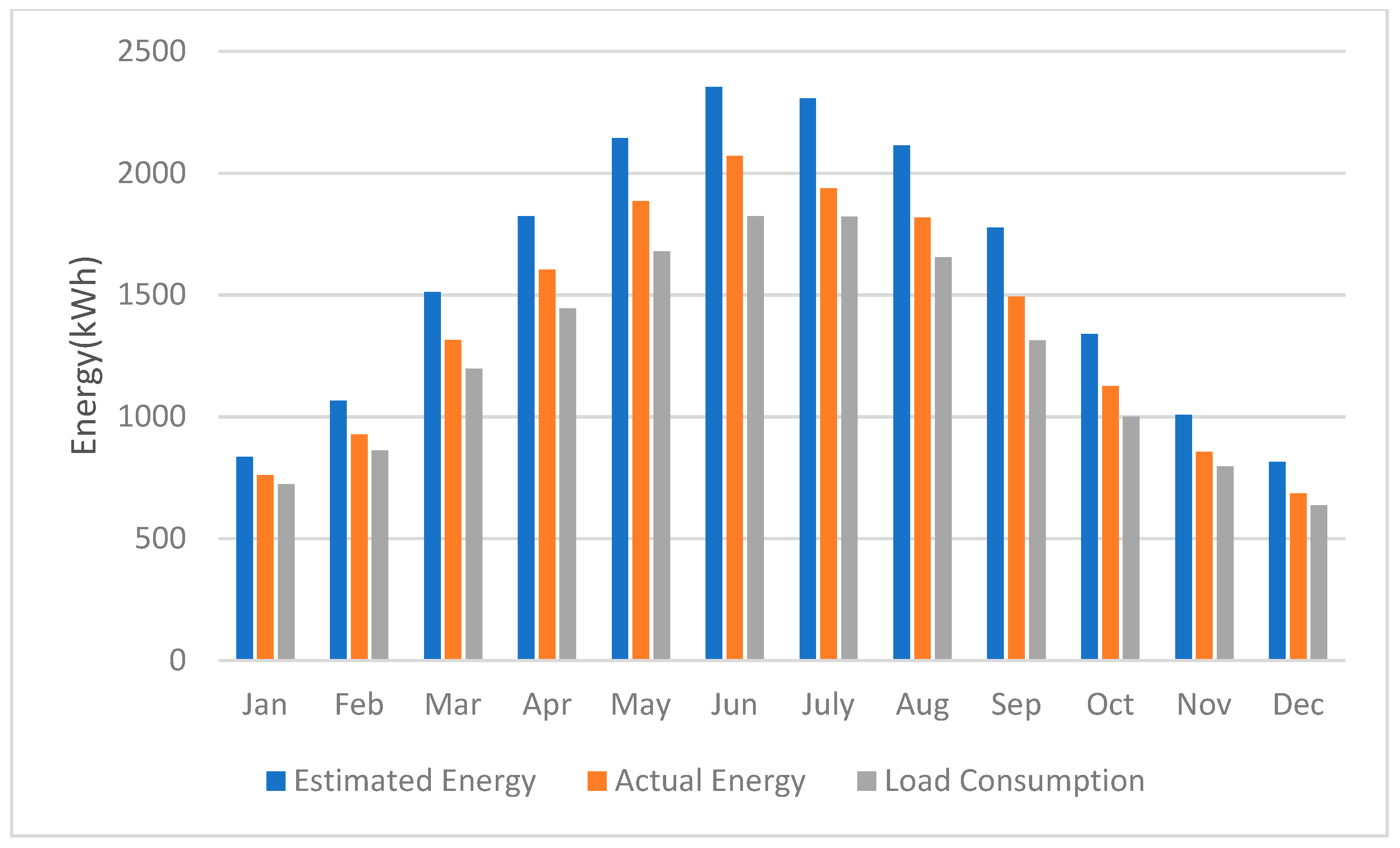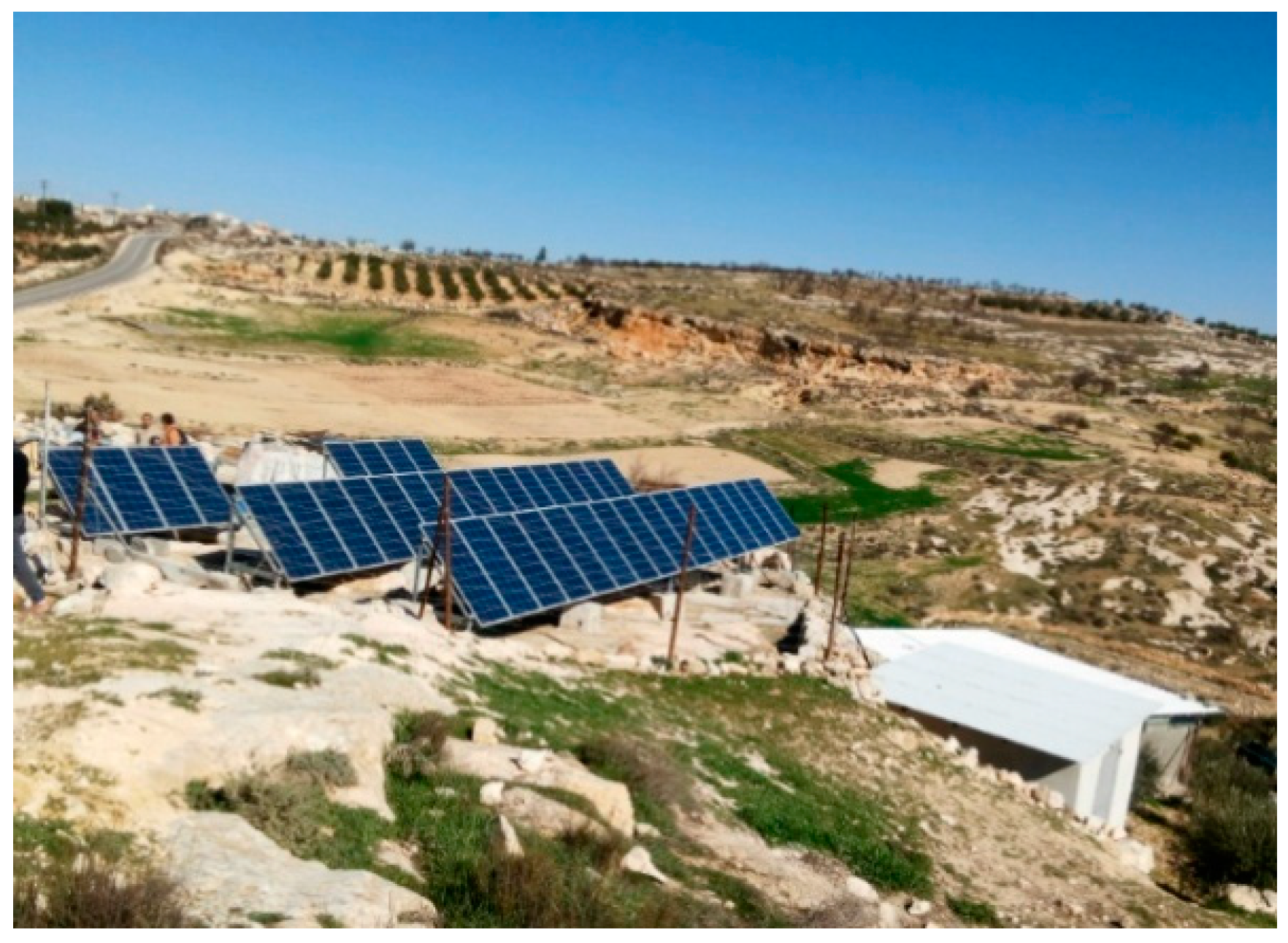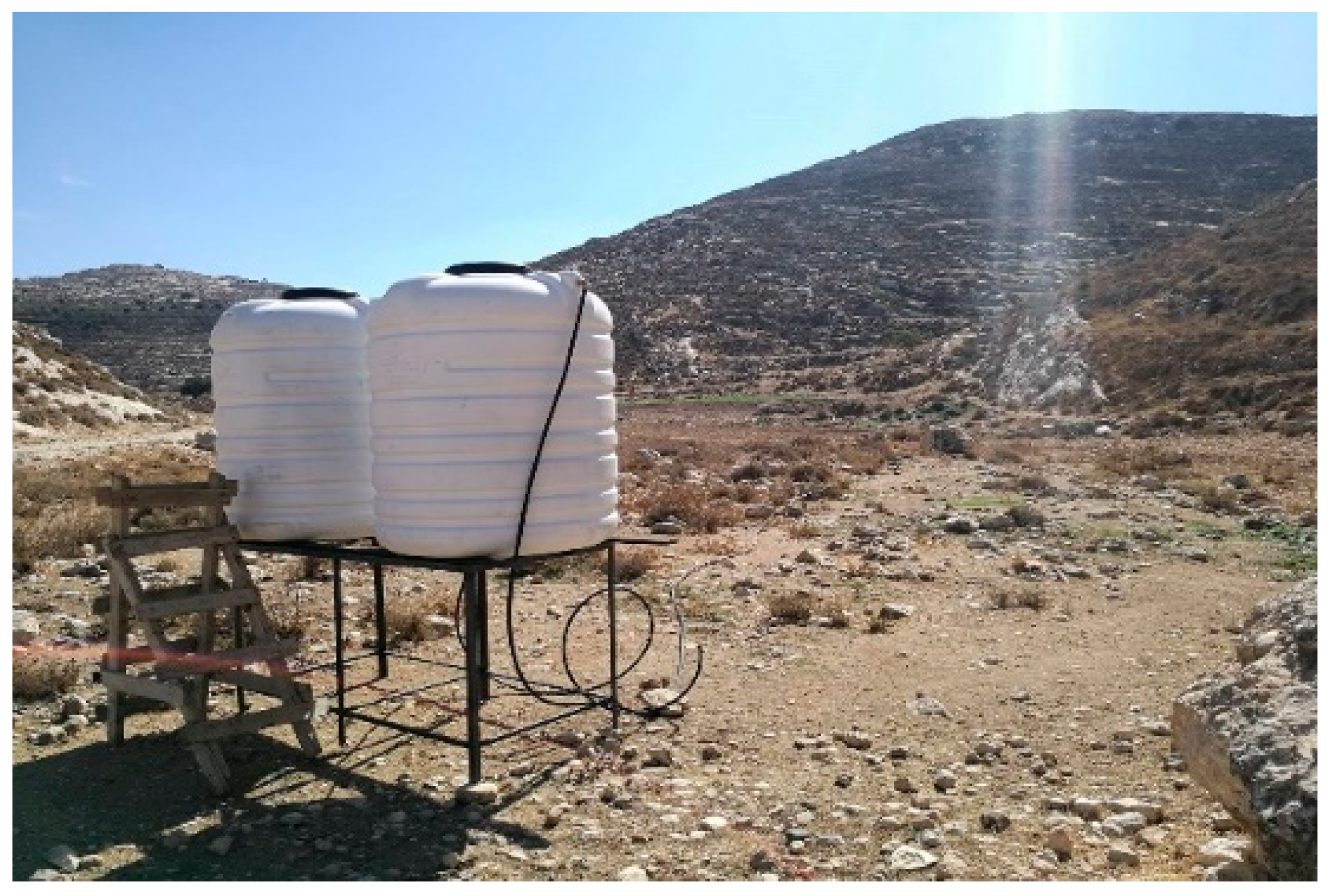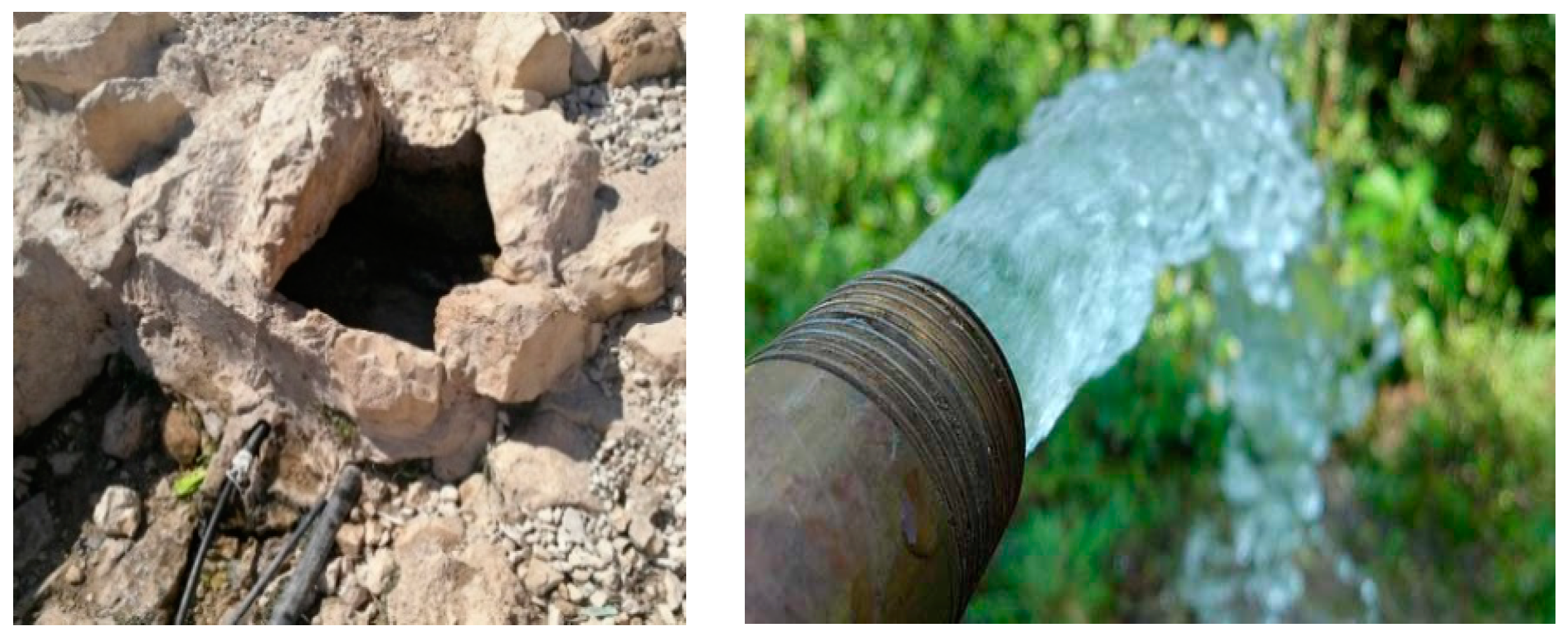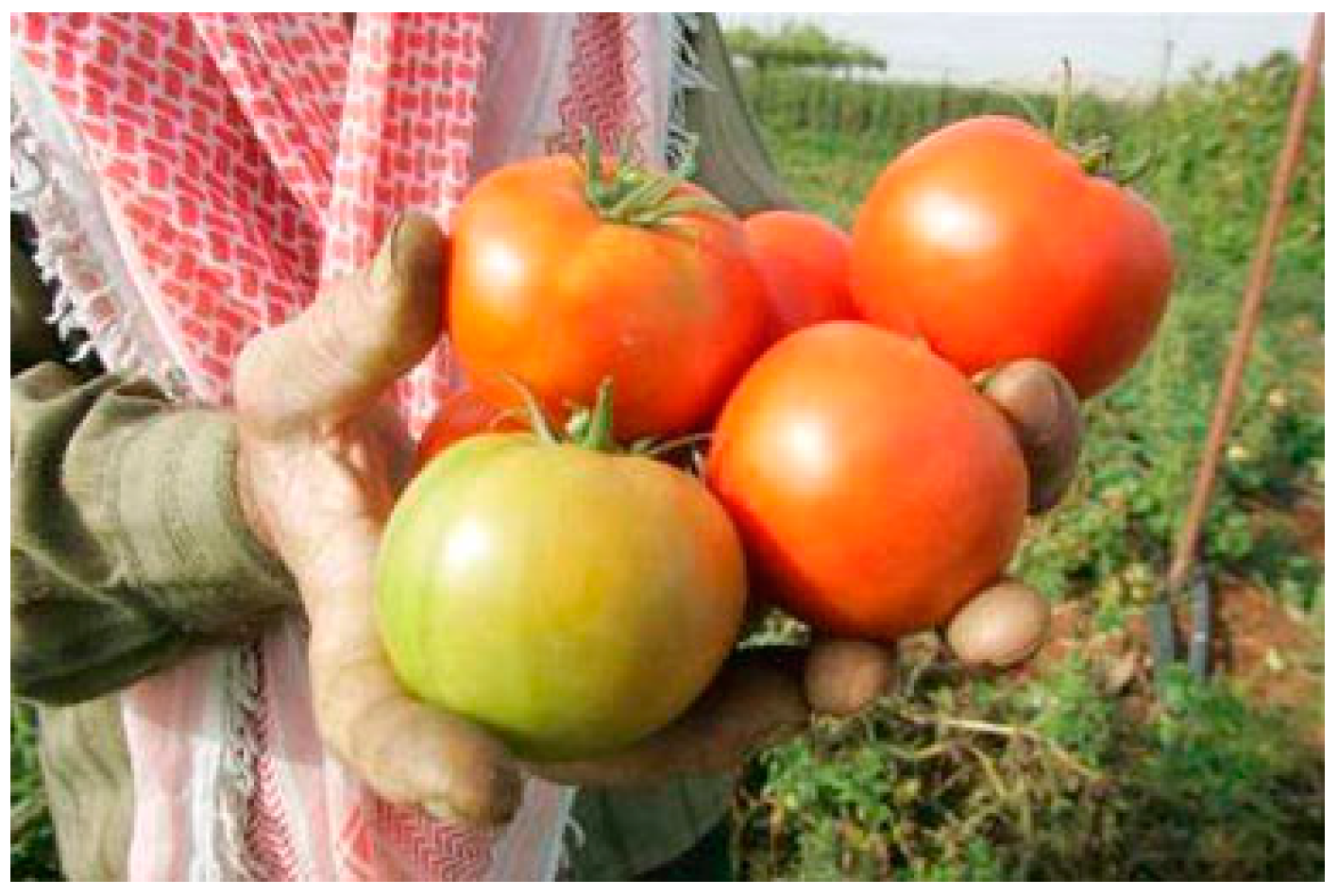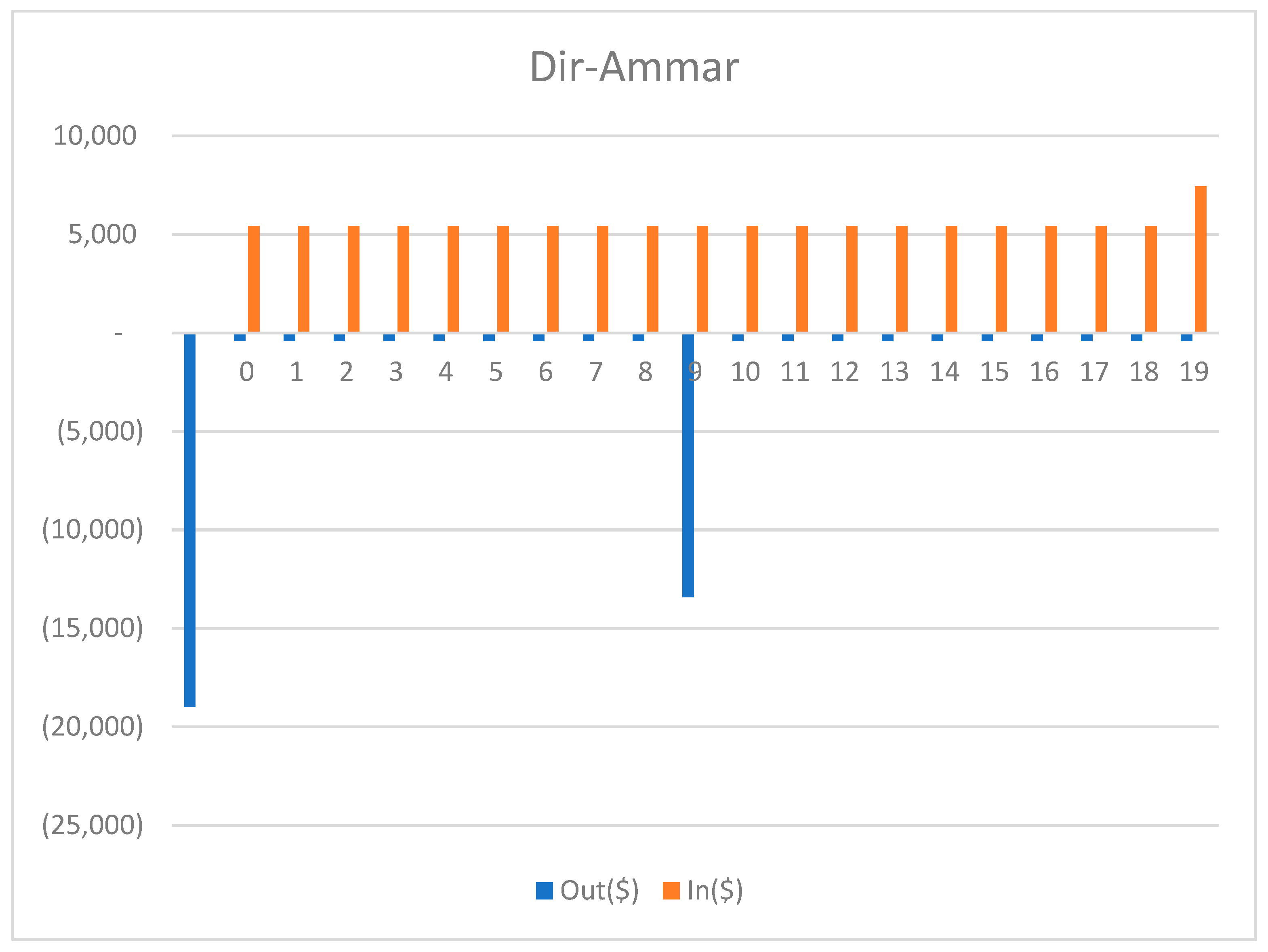1. Introduction
Palestine still has a number of remote small communities without access to electricity. It is unlikely for these communities to be connected to the local power grid in the near future as a result of political conflicts and financial issues. The unavailability as well as the lack of sufficient electricity is still one of the main issues hindering socio-economic development in Palestine, especially in its rural areas. The electricity is typically used for potable water pumping, irrigation, lighting and cooking (Imad, 2019) [
1].
In some remote areas located in the Palestinian territories, diesel generators are still used to power homes and pump water for a limited period of time during a day. Therefore, a solar photovoltaic (PV) powered irrigation system can be a practical choice for irrigating by utilizing solar PV systems. Such a system can be employed as an alternative so as to provide isolated villages and localities with energy, especially given that Palestine has a daily mean of 5.6 kWh/m
2 of solar radiation and 3000 sunshine hours per year (Mason, 2009) [
2], that is to say the region is well-suited to PV installations, (Juaidi et al., 2016) [
3]. At the same time, Palestine suffers from scarcity of water and arable land. As a result, the Palestinian government provides assistance with PV schemes to encourage rural farmers to install solar PV pump systems.
Generally, Palestine has a Mediterranean climate characterized by long, hot, dry summers and short, cool, rainy winters,
Table 1 below shows the maximum, minimum and mean temperatures, annual rainfall and number of cloudy days in Palestine.
This paper describes how a micro grid solar PV system with lead-acid storage batteries may be utilized for rural electrification and water pumping. Two PV system installation processes have been completed, in both Al-Birin and Dir Ammar small village (hamlet) communities, in order to provide electricity access and pump water. In this paper, a solar PV system design for electrification and irrigation is presented, along with the techno-economic feasibility of substituting the existing diesel engines for solar photovoltaic (PV) systems. Solar PV systems were found to be more economic in comparison with diesel use in rural, urban and remote regions in Palestine. The investment payback for solar PV systems rather than diesel was estimated at 3.5 years.
Therefore, the main goal of this paper is to illustrate the real feasibility of using micro-grid solar PV systems instead of diesel generators in different areas to promote rural development and sustainable agriculture in Palestine by drawing on the performance assessment results. The monthly amount of the energy generated from solar PV systems was recorded by data loggers and analyzed against the total solar irradiation measured by a local weather station.
The Energy Research Center at An-Najah National University designed and installed two PV irrigation systems for remote Palestinian communities in 2017. This paper summarizes the design and documents the systems’ performance over their first year of operation.
2. Literature Review
Existing research literature has indicated that more than 1.5 billion people worldwide are living in rural areas in developing countries without access to electricity. Many countries seek to improve the quality of life of their citizens and increase the economic well-being of the families who live in rural areas, even though they are relatively isolated and live in small families, which are few in number (Feron, 2016) [
4].
Over the past years, health and education have mainly been the focal points of social development (Rowley, 1996) [
5] and these sectors have been acknowledged, along with others, such as tourism, recreation and decentralized manufacturing. Nowadays, one of the main sectors which is perceived as the core of rural development is agriculture, i.e., food security, since it can be considered as the most important sector for developing rural areas in the world. In fact, many communities in Palestine have serious problems in terms of the scarcity of water and energy (Imad, 2019; Rehan, 2019) [
1,
6].
Many researchers have investigated the sustainable development of rural communities, and it has been shown that there is a link between the enhancement of energy and that of water and food supplies. Querikiol (2018) [
7] evaluated the performance of a 1.5 kW solar PV system in an agricultural farm located in Camotes Island, mainly for agricultural water use; it was found that around three cubic meters of water per day would be necessary for land irrigation. Additionally, it was concluded that the capacity of the required water pump in order to provide the required irrigation would be 360 W. It was pointed out that it had a very good overall performance; this would prove the potential success of other applications of solar systems operationalized for agricultural purposes.
Santos et al. (2018) [
8] proposed a framework for designing a micro-grid system after examining technical, economic as well as social issues so as to determine the optimum required system.
As for research, Chel and Kaushik (2011) [
9] analyzed the economic impact, along with the environmental impact, of using solar pumps so as to attain sustainable agriculture. The author of [
8] pointed out the role that solar energy plays in farming, namely strengthening all agronomic parameters with regard to ecological efficiency, environment and social impacts, in addition to feasibility. Al-Saidi and Lahham (2019) [
10] evaluated the nexus approach, which has been adopted and whose projects have been implemented in the Azraq Basin, Jordan. Through adopting a nexus perspective, the authors of [
8] assessed the feasibility and the requested incentives in order to encourage farmers to use standalone solar PV systems. Furthermore, Kyriakarakos et al. (2020) [
11] discussed high-cost rural electrification projects by examining a number of methods which could be followed to cover the costs required to implement them, including increasing the cost of produce and plant products in addition to subsidizing the cost of solar PV systems. This approach has been implemented in Rwanda and has led to subsidizing the local agricultural cooperatives and promoting electrification activities in rural areas.
This paper evaluated the performance of an installed 6.2 kW, 9.6 kW off-grid micro-grid solar PV system in terms of its ability to meet the irrigation and other operational requirements of a 4-hectare and 5.5-hectar plantations located in Dir Ammar and Al-Birin areas, respectively. The agricultural lands vary between flat and wavy lands for the cultivation of various types of grains and vegetables, sloping lands for the cultivation of fruit trees, and steep, rugged lands in which forests and natural herbs grow suitable for grazing. Olives are one of the most important agricultural crops in these areas, as they occupy the largest cultivated area and almost surround the town in all directions.
The main aim of this study is, therefore, to contribute to the evaluation of the potential impact of implementing solar PV systems on sustainable agriculture and rural development in Palestine, especially concerning the possibility of income-generating activities. It is important to identify the potential contribution of solar PV, as a replacement of diesel generators, to ensure rural development and gain further income and political commitment because such solar projects may expand to other areas and may help ensure solar PV is designed appropriately, under real-life environmental conditions.
3. Case Studies: Dir Ammar and Al-Birin Small Villages (Hamlets) in the West Bank, Palestine
Both Dir Ammar and Al-Birin small villages (hamlets) are located in Palestine and face relatively similar circumstances in terms of their access to electricity. On the one hand, Dir Ammar is a town located in Ramallah Governorate, 20 km northwest of the city of Ramallah in the north of the West Bank, located at latitude 31°58′00″ N and longitude 35°06′07″ E.A. The community in the above-mentioned hamlet suffers from lack of supplies and relies on diesel generators for household electrification and land irrigation. On the other hand, Al-Birin hamlet is in the southeast of the Hebron District. At a distance of 10 km, the city of Hebron is the closest to this community; it is located at latitude 31.489668° and longitude 35.147839°. Similar to Dir Ammar, this community also depends on a diesel generator for generating electric power.
Through the assessment of non-electrified villages in Palestine in 2017, we found that Dir Ammar and Al-Birin communities are two suitable villages for the implementation of micro-grid solar PV systems. The villages are located near Israeli settlements; thus, the process of supplying them with the conventional power supply from the grid proved to be challenging for implementation. Funded by the Spanish Agency for International Development Cooperation (AECID), micro-grid centralized solar PV systems were installed in 2018 as rural development projects in Palestine. The present paper examines the socio-techno-economic impact of these projects under the circumstances (Ibrik, 2016) [
12].
The number of the inhabitants of Dir Ammar and Al-Birin does not exceed 180 individuals who live in 24 houses. Most of those who live in the aforementioned communities mainly work as farmers and cattle breeders, whereas some are construction workers. The location of these communities are in area C, where Israel does not allow Palestinian to expand the electrical network to this area. This encouraged us to select these remote areas to be a model for a solar electrification and water irrigation in Palestine. Local wells supply water to the villages for the most part. Old generators were only used for 4–5 h per day due to their high fuel prices and high-level consumption; the cost of 1 kWh electricity production was around
$0.5.
Table 2 shows the daily consumption allocated for these communities. The cost of diesel/liter is around 1.5
$/L, because the diesel generators are very old, and the diesel consumption is around 0.3 L/kWh. The overall efficiency of the existing generators is around 32%.
In winter, it is not necessary to use energy for irrigation. For some days in winter and cloudy weather, the output of the PV system is very low. In summer, there is more output energy and, at the same time, more need for drinking and irrigation.
Each house is fitted with an energy dispenser and meter, which limits the amount of energy available for each user in accordance with their predetermined needs and the contracted tariff. In order to avoid flattening of batteries, the diesel generator works for a few hours in winter to fill the batteries.
Instead, solar PV systems are now installed for electrification and for water pumping in these communities as such systems, rather than diesel generators, are now deemed to offer the best solution and feasible method for irrigation in Palestinian rural communities.
Table 3 compares the use of diesel generators for irrigation as opposed to solar PV systems, taking Dir Ammar as a case study. It can be noticed that using solar PV is more sustainable, eco-friendly and encourages the socio-economic development of these communities, and it can help to solve the energy crisis which Palestinian farmers face.
In this study, the micro-grid in each community was built, and it consists of an over-head line (3 × 6 mm2 PVC), 11 poles and cables (3 × 4) mm2 for the connection users in each location. The performance analysis and a feasibility study of deploying solar photovoltaic systems for water pumping and for electrification of rural areas in Palestine are presented based on real input data from both implemented projects.
4. System Design
4.1. Determining Solar Irradiation
The solar energy data were collected from weather stations near the hamlets Dir Ammar and Al-Birin. The average recorded data indicated that the solar radiation rate was 5.5 kWh/m
2-day, and the maximum solar radiation almost reached 8.2 kWh/m
2-day in July, while the minimum was about 2.8 kWh/m
2-day in December.
Figure 1 shows the average monthly irradiation for both sites.
4.2. Elements of System Design
4.2.1. Electrical Load
The main loads in each village reflect the inhabitants’ daily power consumption and water pumping as well as their electricity demand. These figures have been obtained using a questionnaire.
Dir Ammar’s deep water well specifications are listed below:
Total dynamic head = 20 m
Daily water consumption required: 60 m3/day.
Diesel consumption = 3 L/day, needed monthly diesel = 90 (L/month)
The specifications of deep water wells in Al-Birin are as follows:
Total dynamic head = 30 m
Daily water consumption required: 80 m3/day.
Diesel consumption = 6.5 L/day, needed monthly diesel = 200 (L/month)
The dynamic head is the total equivalent height that a fluid is to be pumped. The hydraulic energy (HE) can be calculated as in (1) in Amjath et al. (2019) [
13].
where Q is the water pumping rate (m
3/day) and TDH is the total dynamic head (m).
The electrical energy required for water pumping is calculated as in (2).
where ηs is the efficiency of the system components.
The calculated total daily loads including water pumping for these communities are indicated in
Table 4.
Table 2 shows that by deploying high efficiency pumps and appliances to carry out these projects, the total consumption may be around 23.5 kWh/day in Dir Ammar but 36.2 kWh/day in Al-Birin.
4.2.2. Sizing Solar PV Systems
To determine the capacity of the required solar PV system to supply the average daily load consumptions of these communities, Equation (3) was used (Imad, 2019) [
1].
Ecos: average daily consumption in kWh/day
P.S.H: peak sunshine hours (5.5 h) (Imad, 2019) [
1]
ηinv: inverter efficiency (97%)
ηbat: battery efficiency (85%)
Sfac: factor of safety (1.2)
The total power of Dir Ammar’s PV system, PV-system = 6.2 kWp.
The total power of Al-Birin’s PV system, PV-system = 9.6 kWp
In both projects, a solar PV module capacity of 395 W was installed, so the number of modules in the system was determined as in (4).
The number of solar PV system modules in Dir Ammar is 18; however, there are 24 modules in Al-Birin.
4.2.3. Determining DC System Voltage
The selected DC system voltage of the micro-grid solar PV system equals 48 Vdc. The number of series modules, Ns, can then be calculated as in (5).
= 48/18.1 = 3 module in series
The PV system in Dir Ammar is composed of two arrays; each consists of 3 × 3 PV modules. Similarly, Al-Birin’s is composed of two solar arrays; however, each array has 3 × 4 PV modules, which are installed on galvanized steel supports, a south-facing, horizontally-oriented surface at a tilt angle of 30 degrees for optimum performance throughout the years.
4.2.4. Selection of Battery Bank
In micro-grid solar PV, the battery constitutes an important part of system. The needs of the community are met whether at night or on cloudy days, which requires a high number of charge-discharge cycles, by selecting the most appropriate battery.
The battery is selected in ampere hours, as in Equation (6).
Na: autonomy days (1.5–3 days)
Vbat: system battery voltage =, 48 V
DOD: depth of discharge (0.35)
For Dir Ammar, total CAh = 1700 Ah, and for Al-Birin, total CAh = 2600 Ah.
For limitation of budget, we selected 1800 Ah for both sites, the characteristics of the lead-acid batteries deployed in both sites are mentioned in
Table 5. The storage system is composed of 24 deep cycle batteries. Each element is a 2 V battery with a capacity of 1800 Ah (C10), connected in a series.
The total available energy in batteries can be calculated as in (7).
CWh = 1800 Ah × 48 V = 86.4 kWh for Dir Ammar and CWh = 86.4 kWh for Al-Birin
4.2.5. Selection of Charge Controller
For controlling the charge-discharge cycles, the selected charge controller prevents issues related to overcharging as well as deep discharging, the selected controllers are using a maximum power point tracker (MPPT) in order to maximize the solar PV power.
The capacity of the charge controller is selected based on the PV maximum current, taking safety, as a factor, into account as shown in (8).
Therefore, a 100 A MPPT, STUDER VarioTrack VT-100 was selected as the installed PV charge controller; the maximum efficiency reached 97.5%.
4.2.6. Selection of Inverter
We selected single phase inverters to supply single-phase water pumps used in the projects whose system output voltage was 230 V/50 Hz each, as follows (Imad, 2019) [
1]:
Rating inverter = PV rating = 395 Wp × 18 = 7110 W for Dir Ammar and 9480 W for Al-Birin.
The inverter was used to convert DC power of PV arrays to AC power; the voltages and currents were suitable for operating domestic appliances in a consumer’s household and driving the pump electric motor.
The input energy of inverter = PV rating × P.S.H.
= 7110 × 5.5 = 39.1 kWh/day
The total energy output of inverter = total energy input of inverter × ηinv
= 39.1× 0.95 = 37.1 kWh for Dir Ammar and 49.5 kWh for Al-Birin.
We selected 48 Vdc operating voltage inverters whose output voltage was 230 V/50 Hz, with a capacity of 10 kW in Dir Ammar and 12 kW in Al-Birin.
A comparison between different scenarios regarding solar capacity and storage system were studied and the results are shown in
Table 6 and
Table 7.
We selected the optimum scenarios which would give minimum cost for each community.
4.2.7. Electricity Installation
Each house is fitted with an energy dispenser,
Figure 2, and meter, which limits the amount of energy available for each user in accordance with their predetermined needs and the contracted tariff.
Users are trained to make efficient and rational use of the energy in the household. The corrective (vs. preventive) maintenance technician is a contracted professional in charge of repairing potential failures of the system and of keeping it in optimal condition. He is trained on the functioning of the micro-grid with adequate workshops and technical materials and manuals. The users in both communities are enjoying a 24-h quality electricity service.
As to the economic structure of the service, its goal is to guarantee the economic sustainability of the project. Thus, the fees paid by users stay in the community and are kept by the operator (a special bank account is created for the project in each community). The payment of fees is aimed at covering the expenses of operation and maintenance (O&M) of the system, that is, the cost of components, diesel for the generator to operate for a few hours in winter time, transport, spare parts, etc. This economic sustainability is highly dependent on the users’ capacity and willingness to pay the fees.
One very essential element for long-term sustainability we are dealing with is the feeling of appropriation of the project by the community. Our experience has shown that the more informed the people are, the more involved. Thus, regular informative meetings are very necessary. Other key elements here are the local management of the service, which gives the community a sense of sovereignty (that is, they are not dependent on the electricity company or of Israeli supply); good training (on the rational use of energy, the individual energy control, …), which makes them feel more confident in the use of the service; and finally the empowerment of women, who at the end of the day are the ones managing the electricity use in the households.
4.3. Energy Generated by Micro-Grid Solar PV
The hourly data was collected using a data logger and recorded in the monitoring system each hour. The total annual output energy can be calculated as in (9).
where n1 = January… n12 = December
As illustrated in
Figure 3 and
Figure 4, the power output and the actual monthly consumption are compared with an estimated solar panel output using “PV sys” Software program.
Estimated output is the output energy expected to be produced according to average solar radiation in the West Bank (Palestine), while the actual output is the real output based on real solar radiation. The solar PV system is normally expected to produce the most ideal output “optimum” energy, but in reality the output power will be dependent on real solar irradiance and temperature and on the electrical losses in the system; therefore, the actual energy output is usually less than the estimated.
In Dir Ammar the maximum output was 1337.2 kWh in June 2018, yet in December, it reached 452.6 kWh. As for the Al-Birin system, the maximum output energy was 2070.6 kWh in June 2018 and 684.6 kWh in December.
5. Performance Analysis of Rural Electrification Using Micro-Grid Systems in Palestine
5.1. Performance Ratio (PR) of Solar PV Systems
The PR in Equation (10) can be calculated by dividing the actual output generated energy by the estimated output energy as in (10); the suitable range of this factor is 68–90% (Ghouari, 2016; Otaibi, 2015) [
14,
15]. The calculated PR for both systems is shown in
Figure 5.
For Dir Ammar, the yearly average PR is 88%, and for Al-Birin, the yearly average PR is 86%.
5.2. Capacity Utilization Factor (CUF)
The CUF is a factor which measures the actual energy output against the nominal energy output of the installed power at a specific period, as in (11) (Amjath, 2019; Ibrik and Hashaika, 2019) [
16,
17].
The CUF has been calculated for both systems, and the results are shown in
Figure 6.
Figure 6 indicates that the annual average CUF is 20.27%; the maximum value is 29.9% in June, and the minimum is 10.14%, in December.
6. Social and Economic Impact of Solar PV Systems in Dir Ammar and Al-Birin Communities
6.1. Social Impact
Based on real-time data collection from both communities, Dir Ammar and Al-Birin, it was concluded that rural electrification had changed the status of these small villages and had created economic, socio-cultural and demographic impacts on the daily lives of both communities.
Energy access has considerable, sustained impacts on poverty as it helps to reduce it. Moreover, other significant aspects may be influenced by rural electrification, including health, education and childcare as well as female employment (Mondal, 2011; Khan, 2014) [
18,
19]. It was found that the availability of energy provided access to potable water. In fact, not only does safe drinking water play an essential role in maintaining an individual’s health, but it also has a major impact on agricultural development. Furthermore, having energy access stimulates agro-food industries since micro-grid solar PV systems are likely to provide electricity services to these remote communities as well as rural areas, which still deploy diesel engines. Solar PV may also improve healthcare quality, agriculture and the availability of electricity and water supplies in these poor areas (Mala, 2009; Epstein, 2016) [
20,
21].
Using solar pump systems provides a reliable, sustainable energy source for irrigation. In terms of the economic impacts which these systems have, the farmers cut back on diesel consumption and save money. The agricultural output increases and farmers’ incomes as well as increases, now they can enhancing crop productivity and being able to perform multiple cropping cycles during the year, which boosts their income, enhances their resilience, improves food security and contributes to cutting poverty in the communities (Hirmer, 2014; Müggenburg, 2012) [
22,
23].
These implemented projects proved to be successful as the beneficiaries reported their satisfaction. While the two rural areas’ inhabitants had no access to electricity and, instead, had to use primitive tools, such as candles, before carrying out the projects, they now feel safer and closer to one another as they can participate in other nighttime activities, such as spending quality time with their families, which helps strengthen their ties.
Moreover, the time spent by the women involved in dairy production or doing house chores was reduced, allowing them to pay visits to one another and take better care of their children, so 63% of women reported the positive effects of the PV system on their lives.
The project affected the behavior of children positively. Twenty percent of the children who live in the villages under the study pointed out that studying at night was no longer impossible. Prior to the implementation of the projects, those children were without light at night; keeping in mind that 50% of the children did not attend school because they were either in their pre-school years or females who were not allowed to go to school because of the fear for their safety due to the dangers imposed by settlers, 20% could be considered as an acceptable percentage.
The houses in each community are close to each other as clear in
Figure 7 and
Figure 8.
Figure 9 indicates that through implementing the aforementioned solar PV projects in both communities, both villages now have access to electricity round the clock. In the same way, the generated energy has also improved access to water sources; water is stored in water tanks and later used for drinking (see
Figure 10) and for solar-powered irrigation pumping, as shown in
Figure 11. These sources have enabled poor farmers to improve their agricultural productivity as well as their vegetable production and cropping intensity at low costs while providing a cleaner and greener alternative for irrigation, as demonstrated in
Figure 12. The water pump fills the water storage tanks during sunshine hours and the farmers irrigate the crop fields mainly at night and according to a specific schedule. Farmers can now cultivate more crops annually which will boost their incomes, enhance crop resilience, improve food security and alleviate poverty.
6.2. Economic Impact
The economic impact of the proposed micro-grid solar PV systems can be determined using different methods, all of which depend on the life cycle costing (LCC) (Barringer, 1995; Fuller, 1996) [
24,
25].
The proposed LCC consists of investment, replacement and operation costs, in addition to the cost of owning it over its lifetime.
The breakdown cost for each system is shown in
Table 8.
The replacement cost in year 10 will include the cost of replacement batteries, charge controller, and inverter; the estimated cost can be considered as the following:
- -
For Dir Ammar: 13,000 $ including transportation and installation.
- -
For Al-Birin: 15,000 $ including transportation and installation.
The rate of return (ROR) and simple pay back period (SPBP) methods were used in this evaluation.
6.2.1. Rate of Return Method
For feasibility evaluation, the rate of return (ROR) method can be employed so as to assess if a project or investment is economically justified (Yoomak, 2019; Firouzjah, 2018) [
26,
27]. The ROR method is expressed as the rate of interest earned on the unrecovered balance of the capital cost. The process of calculating the ROR value does not resemble that of calculating the present worth (PW) or annual worth (AW) for a series of income and outcome cash flows. The PW technique through the LCC of cash flow was adopted in the present study, as shown in
Figure 12, with regard to the Dir Ammar project, and
Figure 13, with regard to Al-Birin’s. The LCC includes the initial cost of the project, operation and maintenance (O & M) costs, battery replacement costs, scrap value and saving ‘revenue’ from annually produced energy. In the savings calculation, the output energy cost equaled 0.5
$/kWh (Imad, 2019) [
28], as it replaced the cost of using diesel. The annual saving of produced energy is determined as in (12).
Annual saving for Dir Ammar = 10,861 × 0.5 = 5430.25 $ and for Al-Birin = 16,478 × 0.5 = 8238.5 $.
The cash flow that is shown in
Figure 13 and
Figure 14, the investment cost, battery replacement and O & M costs are considered as outcomes while the annual savings and the scrap value are considered as incomes.
PW (output) = investment cost + (P/A, i, 20) of operation cost + (P/F, i, 10) of battery replacement cost.
P/F,i,10 = finds the equivalent present value from future value at i% interest for 10 years.
P/A,i,20 = finds the equivalent present value from given annual value at i% interest for 20 years.
Where the interest rate i = 10%
PW (input) = (P/A, i, 20) of Energy savings + (P/F, i, 20) of scrap value.
For Dir Ammar:
PW (output) = 19,000 $ + 420 $ *(P/A, i, 20) + 13,000 * (P/F, i, 10)
PW (input) = 5430 * (P/A, i, 20) + 2000 * (P/F, i, 20).
For Al-Birin:
PW (output) = 25,600 $ + 520 $ * (P/A, i, 20) + 15,000 * (P/F, i, 10)
PW (input) = 8238.5 * (P/A, i, 20) + 3000 * (P/F, i, 20).
Using an Excel sheet, the ROR for Dir Ammar equaled 23.28%, yet for Al-Birin, it was 27.83%. This suggests that these projects will return 25.55% of their initial costs annually; in other words, these projects are feasible.
6.2.2. Payback Period (SPBP)
The SPBP method is used also to determine the project feasibility, and it can be calculated using Equation (13) (Berk, 2012; Brealey, 2012) [
29,
30].
S.P.B.P for Dir Ammar = 3.5 years, and for Al-Birin the S.P.B.P = 3.1 Years
The SPBP for both projects is around 3.5 years. Alternatively stated, all the expenses are to be recovered by the first 3.5 years, whereas the rest, which add up to 16.5 years, are to be considered as a profit, which proves the feasibility of implementing these projects.
7. Environmental Impact
The replacement of diesel generators with solar PV systems has a significant environmental impact especially on the atmosphere due to the entailed reduction of combustion processes. The amount of CO2 emitted per kilowatt-hour (kWh) depends on the method of generation, diesel, nuclear, coal, gas…and so forth. The estimated annual reduction of CO2 emissions in Dir Ammar is about 2830 kg CO2 and Al-Birin villages about 6288 kg CO2.
8. Conclusions
This study presented a design of a micro-grid solar PV system for electrification and irrigation systems in two rural communities (Dir Ammar and Al-Birin hamlets) in Palestine since this technology is reliable and feasible for irrigation of agriculture crops. The solar PV systems minimize the dependence on diesel as well as conventional electricity sources, which may help solve the problems related to the lack of energy supply in Palestine. This study points out that the total cost of installing solar PV systems, including fixed, running and replacement costs are lower than those of diesel engines.
The implementation of solar micro-grid systems in rural areas suggests a diversity of approaches that address many objectives, such as rural electrification, solar PV dissemination, water availability and increasing agricultural productivity. The implemented projects in the discussed two communities, Dir Ammar and Al-Birin, are integrated into the processes of establishing more direct correlations between producing energy, availability of water and agricultural activities, not to mention increasing the created opportunities with respect to energy, water and food securities.
The performance analysis of micro-grid solar PV systems for electrification and irrigation of land for small communities in Palestine shows very good results. The installation of an electricity dispenser and training for the community on load management and using water for irrigation at night are key factors for no black outs and keeping batteries in good condition. The degree of satisfaction within the community is high, and the social development and utilizing of PV systems is more economically feasible for electrification and irrigation of remote villages of geographic, climate and load conditions similar to Dir Ammar and Al-Birin in Palestine. In addition, micro-grid solar PV systems do not pollute the environment, unlike the use of diesel generators.
